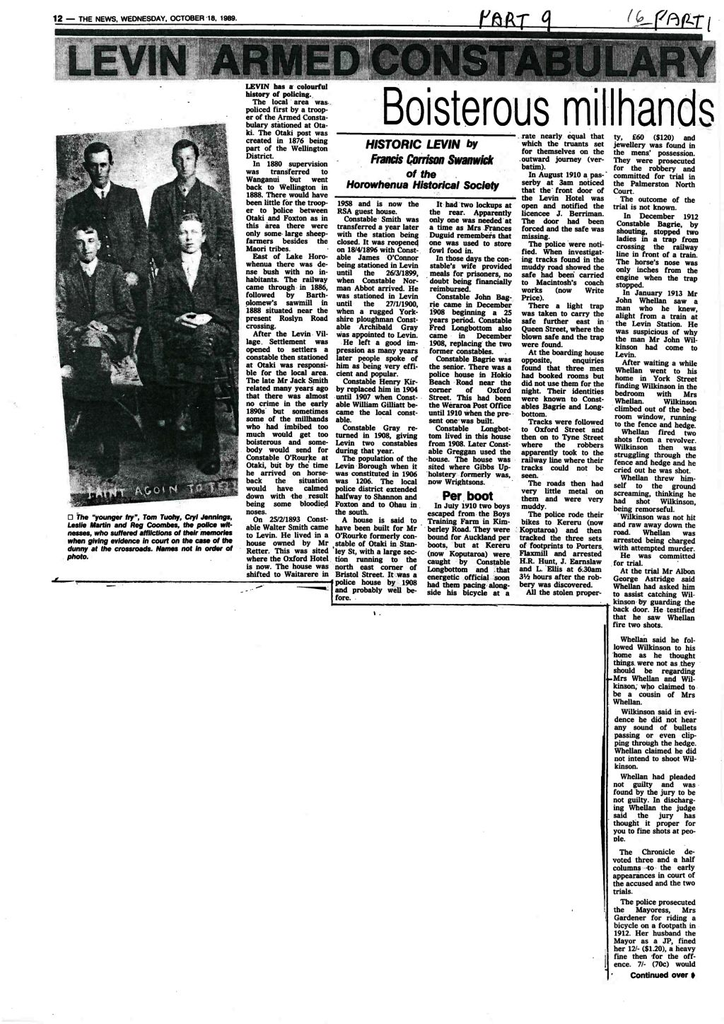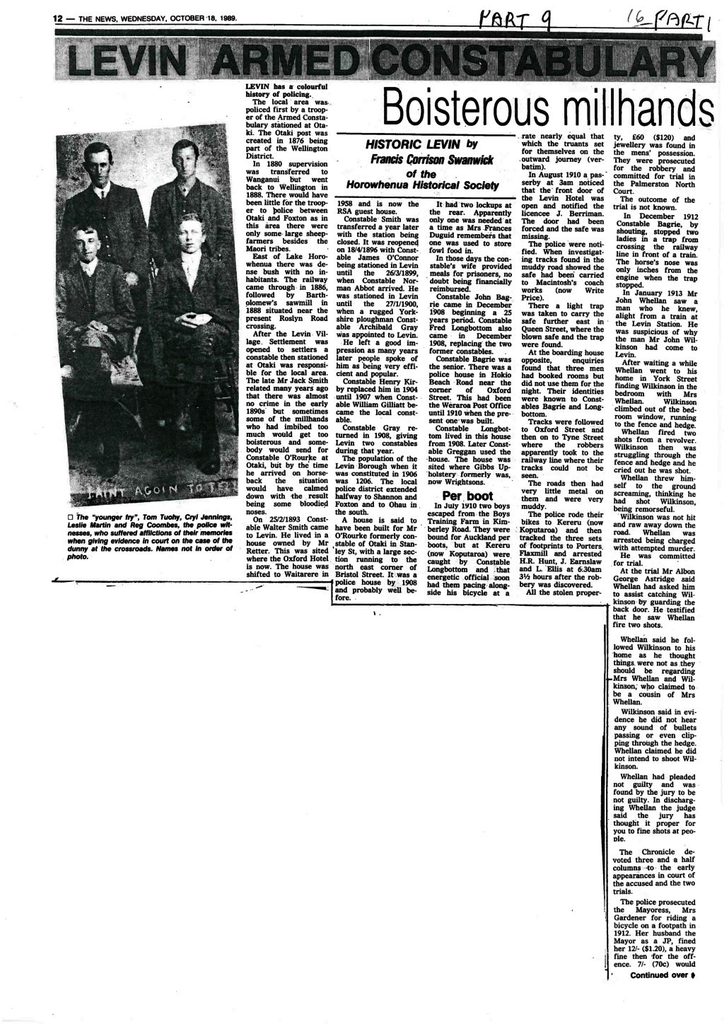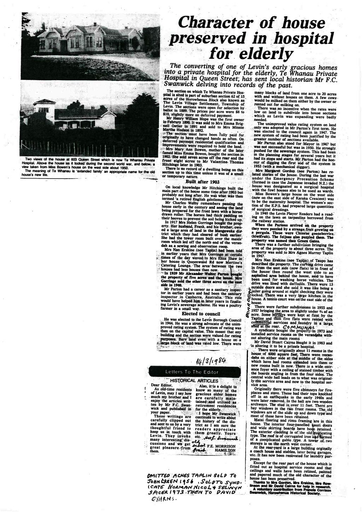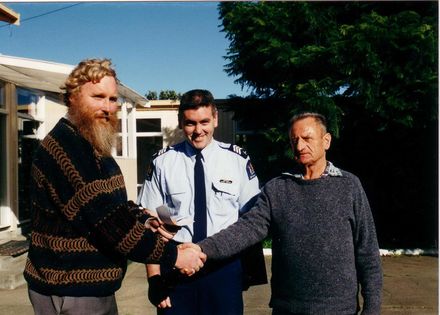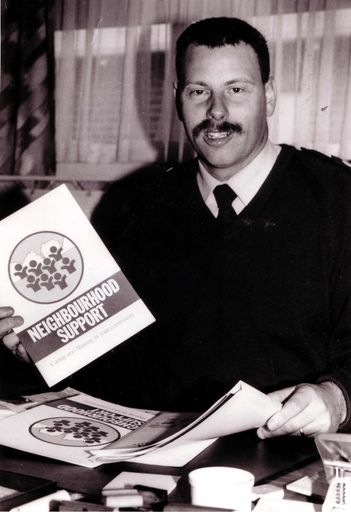This text that follows is the content of the attached PDF.
Levin has a colourful history of policing.
The local area was policed first by a trooper of the Armed Constabulary stationed at Otaki. The Otaki post was created in 1876 being part of the Wellington District.
In 1880 supervision was transferred to Wanganui but went back to Wellington in 1888. There would have been little for the trooper to police between Otaki and Foxton, as in this area there were only some large sheep farmers besides the Maori tribes.
East of Lake Horowhenua there was dense bush with no inhabitants. The railway came through in 1886, followed by Bartholomew’s sawmill in 1888 situated near the present Roslyn Road crossing.
After the Levin Village Settlement was opened to settlers a constable then stationed at Otaki was responsible for the local area. The late Mr Jack Smith related many years ago that there was almost no crime in the early 1890s, but sometimes some of the mill hands who had imbibed too much would get too boisterous, and somebody would send for Constable O’Rourke at Otaki, but by the time he arrived on horseback the situation would have calmed down with the result being some bloodied noses.
On 25/2/1893 Constable Walter Smith came to Levin. He lived in a house owned by Mr Retter. This was sited where the Oxford Hotel is now. The house was shifted to Waitarere in 1958 and is now the RSA guest house.
Constable Smith was transferred a year later with the station being closed. It was reopened on 18/4/1896 with Constable James O’Connor being stationed in Levin until the 26/3/1899, when Constable Norman Abbot arrived. He was stationed in Levin until the 27/1/1900, when a rugged Yorkshire ploughman Constable Archibald Gray was appointed to Levin.
He left a good impression as many years later people spoke of him as being very efficient and popular.
Constable Henry Kirby replaced him in 1904 until 1907 when Constable William Gilliatt became the local constable. Constable Gray returned in 1908, giving Levin two constables during that year.
The population of the Levin Borough when it was constituted in 1906 was 1206. The local police district extended halfway to Shannon and Foxton and to Ohau in the south.
A house is said to have been built for Mr O’Rourke formerly constable of Otaki in Stanley St, with a large section running to the north east corner of Bristol Street. It was a police house by 1908 and probably well before.
It had two lockups at the rear. Apparently only one was needed at a time as Mrs Frances Duguid remembers that one was used to store fowl food in.
In those days the constable’s wife provided meals for prisoners, no doubt being financially reimbursed.
Constable John Bagrie came in December 1908 beginning a 25 years period. Constable Fred Longbottom also came in December 1908, replacing the two former constables.
Constable Bagrie was the senior. There was a police house in Hokio Beach Road near the corner of Oxford Street. This had been the Wereroa Post Office until 1910 when the present one was built.
Constable Longbottom lived in this house from 1908. Later Constable Greggan used the house. The house was sited where Gibbs Upholstery formerly was, now Wrightsons.
Per boot
In July 1910 two boys escaped from the Boys Training Farm in Kimberley Road. They were bound for Auckland per boots, but at Kereru (now Koputaroa) were caught by Constable Longbottom and that energetic official soon had them pacing along side his bicycle at a rate nearly equal that which the truants set for themselves on the outward journey (verbatim).
In August 1910 a passer-by at 3am noticed that the front door of the Levin Hotel was open and notified the licensee J. Berriman. The door had been forced and the safe was missing.
The police were notified. When investigating tracks found in the muddy road showed the safe had been carried to Macintosh’s coach works (now Write Price).
There a light trap was taken to carry the safe further east in Queen Street, where the blown safe and the trap were found.
At the boarding house opposite, enquiries found that three men had booked rooms but did not use them for the night. Their identities were known to Constables Bagrie and Longbottom.
Tracks were followed to Oxford Street and then on to Tyne Street where the robbers apparently took to the railway line where their tracks could not be seen.
The roads then had very little metal on them and were very muddy.
The police rode their bikes to Kereru (now Koputaroa) and then tracked the three sets of footprints to Porters Flaxmill and arrested H.R. Hunt, J. Earnslaw and L. Ellis at 6.30am 3 ½ hours after the robbery was discovered.
All the stolen property, £60 ($120) and jewellery was found in the men’s possession. They were prosecuted for the robbery and committed for trial in the Palmerston North Court.
The outcome of the trial is not known.
In December 1912 Constable Bagrie, by shouting, stopped two ladies in a trap from crossing the railway line in front of a train. The horse’s nose was only inches from the engine when the trap stopped.
In January 1913 Mr John Whellan saw a man who he knew, alight from a train at the Levin Station. He was suspicious of why the man Mr John Wilkinson, had come to Levin.
After waiting a while Whellan went to his home in York Street finding Wilkinson in the bedroom with Mrs Whellan. Wilkinson climbed out of the bedroom window, running to the fence and hedge.
Whellan fired two shots from a revolver. Wilkinson then was struggling through the fence and hedge and he cried out he was shot.
Whellan threw himself to the ground screaming, thinking he had shot Wilkinson, being remorseful.
Wilkinson was not hit and ran away down the road. Whellan was arrested being, charged with attempted murder.
He was committed for trial.
At the trial Mr Albon George Astridge said Whellan had asked him to assist catching Wilkinson by guarding the back door. He testified that he saw Whellan fire two shots.
Whellan said he followed Wilkinson to his home as he thought things were not as they should by regarding Mrs Whellan and Wilkinson, who claimed to be a cousin of Mrs Whellan.
Wilkinson said in evidence he did not hear any sound of bullets passing or even clipping through the hedge. Whellan claimed he did not intend to shoot Wilkinson.
Whellan had pleaded not guilty and was found by the jury to be not guilty. In discharging Whellan the judge said the jury has thought it proper for you to fire shots at people.
The Chronicle devoted three and a half columns to the early appearances in court of the accused and the two trials.
The police prosecuted the Mayoress, Mrs Gardener for riding a bicycle on a footpath in 1912. Her husband the Mayor as a JP, fined her 12/- ($1.20), a heavy fine then for the offence. 7/- (70c) would have been the usual fine for bicycle offences.
Constables Bagrie and Longbottom arrested two men for disorderly conduct in 1913 in Queen Street. A person named McDonald intervened obstructing the police, tripping Constable Bagrie causing him to fall.
The police were able to get the arrested men into Bristol Street on the way to the lockup. McDonald appeared again threatening with a fence batten, forcing the constables to release the arrested men.
They were arrested next day as was McDonald. He was charged with obstructing and assaulting the police.
The magistrate said the charges warranted a jail term, but as McDonald had volunteered to join the army (World War I) he would be fined £10 ($20).
On New Years Eve 1912 there occurred vandalism in Levin, what the Chronicle described as disgraceful, outrageous, offensive and disgusting.
Some shops had white wash daubed on their windows. On Ivess’s shop was daubed in white wash ‘You tried to veto our beer’ and on another window was ‘- (Chronicle reticence) is a wowser’.
The shops which suffered were owned by people who had apparently promoted prohibition in a licensing poll.

A dunny had been carried from somewhere and left in the middle of the Oxford Street and Queen Street intersection, complete with can on the road and labelled Post Office in whitewash, which had been procured from the back of Mr Fred Pink’s shop (now part of Deka).
The last information was told to me by the late Mr Pat Lee.
The police took the names of some alleged offenders. In due course John Ford, Albert, Harold and Charles Mudgeway, Joseph Scott, Fred Ferris and Paddy Dynan were charged in court with having placed an obstruction, an outhouse, on a public road.
 When prosecuting Constable Bagrie said some witnesses had made statements implicating the accused. (When called to give evidence these witnesses, Tom Tuoey, Cyril Jennings, Leslie Martin and Reg Coombes, suffered afflictions of their memories.
When prosecuting Constable Bagrie said some witnesses had made statements implicating the accused. (When called to give evidence these witnesses, Tom Tuoey, Cyril Jennings, Leslie Martin and Reg Coombes, suffered afflictions of their memories.
Photo at left shows the alleged offenders. From left, back row: Fred Ferris, not identified, Joseph Scott, Albert Mudgeway; front row: Harold Mudgeway, not identified, Charles Mudgeway. The two unidentified were John Ford and Paddy Dynan.
These witnesses were much younger than the accused.
The late Mr Pat Lee who remembered the incident called the witnesses ‘younger fry’ when he talked to me. The magistrate dismissed the charges for lack of evidence.
The alleged culprits and witnesses had studio photos taken with inscriptions such as ‘guilty or not guilty’ and ‘I aint goin to tell’.
In 1913 Glackins jewellery shop was entered one night and £150 ($300) of stock stolen. This was the only burglary reported in the Chronicle file of three months. The thieves were arrested in Wellington and convicted later.
In 1915 Constable Longbottom was transferred to Inglewood with Constable William Greggan taking his place and living in the Weraroa police house.
I remember him well as my family moved to Beach Road in 1916.
As children we played with Jean Greggan sometimes in the lockup at the rear of the section.
Bill Greggan was a tall, well-built man with a fine waxed moustache. This was twisted to a fine point on either side and to the width of his face.
The Acclimatisation Society voted £6 ($12) to Constable Bagrie in 1917. He had prosecuted poachers on Lake Horowhenua and the money was half the fines.
On the 31st March 1917 Constable Greggan made a clever arrest. He received information that John Dorn, a prison escapee from Wellington, was at large at Hokio Beach.
Constable Greggan, his wife and daughter went out to Hokio and strolled along, apparently playing aimlessly with the child, until he was alongside Dorn, who was armed with a gun and a revolver.
He threw his arms around Dorn, threw and handcuffed him, taking him to the Levin lockup.
Dorn said his weapons were loaded when he went onto the beach, but seeing the family he withdrew the charges so the family could not be hurt.
When he was thrown Dorn said, “All right I give in, I fell into a fine trap.”
In the same year the Levin Police District was extended from Ohau to two miles below Manakau.
In 1925 Mr and Mrs Brockett went into the Tararua Ranges from Levin with the intention of crossing to the Wairarapa.
They ascended the Ohau River to the confluence of the northern and southern branches and started up Deception Ridge.
Rain and difficult bush made them descend to the river again.
Next day they went further up the river and climbed onto the main range via Girdlestones Track, then dropping down into the Mangahao River. From there they started up a ridge to Dundas Peak, nearly reaching the top.
Gale force wind and rain made them camp for the night at what became known later as Brocketts Rocks only 40 feet (12m) below the summit of Dundas, though they did not know this at the time.
Their tent was pitched between the two very large rocks with the bottom edges being weighted by rocks.

